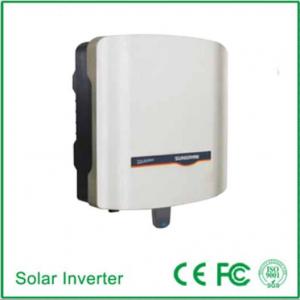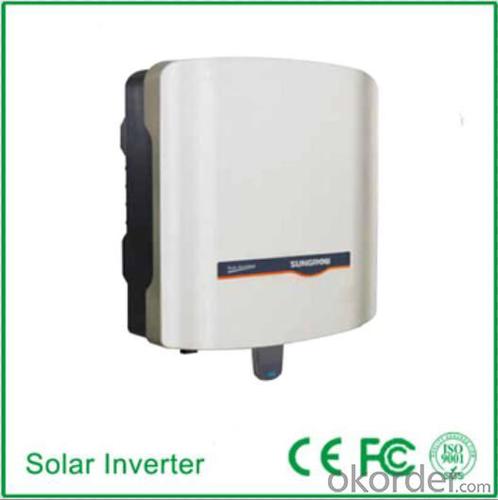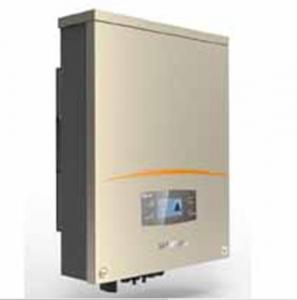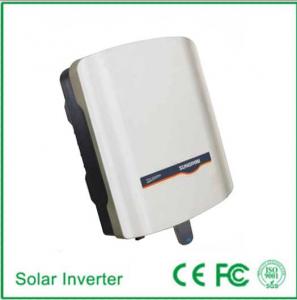Sma Solar Inverter Photovoltaic Grid-Connected Inverter SG4KTL-S
- Loading Port:
- China Main Port
- Payment Terms:
- TT or LC
- Min Order Qty:
- 50000 unit
- Supply Capability:
- 3000000 unit/month
OKorder Service Pledge
OKorder Financial Service
You Might Also Like
1. Structure of Photovoltaic Grid-Connected Inverter SG4KTL-S Description
A solar inverter, or PV inverter, or Solar converter, converts the variable direct current (DC) output of a photovoltaic (PV) solar panel into
autility frequency alternating current (AC) that can be fed into a commercial electrical grid or used by a local, off-grid electrical network.
It is acritical BOS–component in a photovoltaic system, allowing the use of ordinary AC-powered equipment. Solar inverters have
special functions adapted for use with photovoltaic arrays, including maximum power point tracking and anti-islanding protection.
Suitable for 50Hz/60Hz grid, could be used in Asia, Africa and Europe. Available for hand installation, no need for lifting machinery
assistance.
2. Main Features of the Photovoltaic Grid-Connected Inverter SG4KTL-S
• Max. input voltage 600V, compatible with different PV panel and string design
• Only 9kg, easy for handling and installation
• Max. Efficiency at 98.0%
• Ultra-quiet, suitable for residential use
• Access to home WiFi system, easy to enjoy the online monitoring
• Wireless communication design, intelligent mobile phone local and remote monitoring
• Product certification: TÜV, CE, AS4777, AS/NZS 3100, VDE AR N 4105
• Manufacturer certification: ISO 9001, ISO 14001, OHSAS 18000
3. Photovoltaic Grid-Connected Inverter SG4KTL-S Images


4. Photovoltaic Grid-Connected Inverter SG4KTL-S Specification
Input Side Data | |
| Max. PV input power | 4300W |
| Max. PV input voltage | 600V |
| Startup voltage | 150V |
| Nominal input voltage | 345V |
| MPP voltage range | 125~560V |
| MPP voltage range for nominal power | 240~520V |
| No. of MPPTs | 1 |
| Max. number of PV strings per MPPT | 2 |
| Max. PV input current | 18A |
| Max. current for input connector | 20A |
| Output Side Data | |
| Nominal AC output power | 4000W |
| Max AC output power(PF=1) | 4210W |
| Max. AC output apparent power | 4210VA |
| Max. AC output current | 18.3A |
| Nominal AC voltage | 230Vac (Single phase) |
| AC voltage range | 180~276Vac (May vary as per corresponding country’s grid standard) |
| Nominal grid frequency | 50Hz/60Hz |
| Grid frequency range | 45~55Hz/55~65Hz (May vary as per corresponding country’s grid standard) |
| THD | < 3 % (Nominal power) |
| DC current injection | <0.5 %In |
| Power factor | >0.99@default value at nominal power, (adj. 0.8 overexited~0.8 underexcited) |
| Protection | |
| Anti-islanding protection | YES |
| LVRT | NO |
| DC reverse connection protection | YES |
| AC short circuit protection | YES |
| Leakage current protection | YES |
| DC switch | Optional |
| DC fuse | NO |
| Overvoltage protection | Varistors |
| System Data | |
| Max. efficiency | 98.00% |
| Max. European efficiency | 97.50% |
| Isolation method | Transformerless |
| Ingress protection rating | IP65 |
| Night power consumption | <1W |
| Operating ambient temperature range | -25~60℃ (>45℃ derating) |
| Allowable relative humidity range | 0~100% |
| Cooling method | Natural cooling |
| Max. operating altitude | 4000m (>2000m derating) |
| Display | LED, LCD(optional) |
| Communication | WiFi (optional) |
| DC connection type | MC4 |
| AC connection type | Plug and play connector |
| Certification | IEC61000-6-2,IEC61000-6-3, |
| AS/NZS3100,AS4777.2,AS4777.3 | |
| VDE-AR-N-4105, VDE0126-1-1,CE,G83/2,C10/11,EN50438,CGC | |
| Mechanical Data | |
| Dimensions(W×H×D) | 300*370*125 mm |
| Mounting method | Wall bracket |
| Weight | 9kg |
5. FAQ of Photovoltaic Grid-Connected Inverter SG4KTL-S
Q1:Which payment terms can you accept?
A1:T/T,L/C,Moneygram,Paypal are available for us.
Q2:Can we visit your factory?
A2:Sure,welcome at any time,seeing is believing.
- Q: Are there any safety concerns with solar inverters?
- Yes, there can be safety concerns with solar inverters. Some potential issues include electrical shocks from improper installation or maintenance, fire hazards due to faulty wiring or overheating, and electromagnetic radiation. However, these risks can be minimized through proper installation, regular inspections, and adherence to safety guidelines and regulations.
- Q: How does a solar inverter handle variations in ambient temperature?
- A solar inverter is designed to handle variations in ambient temperature by incorporating temperature compensation algorithms. These algorithms adjust the inverter's performance parameters, such as voltage and frequency, based on temperature measurements. This ensures that the inverter operates optimally and efficiently across a wide range of temperature conditions, maintaining stable and reliable power conversion from the solar panels.
- Q: Can a solar inverter be used with a solar air conditioning system?
- Yes, a solar inverter can be used with a solar air conditioning system. The solar inverter helps convert the DC power generated by the solar panels into AC power that is suitable for powering the air conditioning system. This allows for the utilization of solar energy to cool or heat a building, making it an eco-friendly and energy-efficient solution.
- Q: Can a solar inverter be used with a solar-powered security system?
- Yes, a solar inverter can be used with a solar-powered security system. A solar inverter is responsible for converting the direct current (DC) generated by solar panels into alternating current (AC) that can be used to power electrical devices. In the context of a solar-powered security system, a solar inverter is essential for converting the energy generated by solar panels into usable power to operate the security system's components, such as cameras, sensors, alarms, or communication devices. Therefore, integrating a solar inverter is crucial to ensure the functionality of a solar-powered security system.
- Q: Can a solar inverter be connected to a backup battery system?
- Yes, a solar inverter can be connected to a backup battery system. This allows the solar energy generated during the day to be stored in the backup battery system and used during times when the sun is not shining or during power outages.
- Q: Are solar inverters compatible with battery storage systems?
- Yes, solar inverters are compatible with battery storage systems. In fact, solar inverters play a crucial role in integrating battery storage with solar power systems. Solar inverters convert the direct current (DC) electricity generated by the solar panels into alternating current (AC) electricity that can be used to power our homes and businesses. Battery storage systems, on the other hand, store excess solar energy for later use, allowing us to use solar power even when the sun is not shining. When combined with solar inverters, battery storage systems can be charged using the excess energy generated by the solar panels during the day, and then discharge that stored energy during the night or during periods of high energy demand. To facilitate compatibility, solar inverters used in battery storage systems are equipped with additional features and functionalities. For example, they may have built-in charge controllers that regulate the charging and discharging of the batteries, ensuring their optimal performance and longevity. Additionally, advanced inverters may also include smart grid capabilities, allowing them to communicate with the utility grid and optimize energy flows based on grid conditions and electricity prices. Overall, solar inverters are essential components in ensuring the seamless integration of battery storage systems with solar power, enabling us to maximize the benefits of clean and sustainable energy.
- Q: How does a solar inverter handle islanding detection and prevention?
- A solar inverter handles islanding detection and prevention by constantly monitoring the grid and its own power output. If it detects a loss of grid connectivity, it initiates a process called anti-islanding, where it stops supplying power to the grid to prevent the formation of an island. The inverter accomplishes this by monitoring the frequency and voltage levels of the grid, and if it detects a deviation beyond a certain threshold, it disconnects from the grid within a specific timeframe. This ensures that the inverter does not continue to supply power to an isolated grid, which could pose safety risks to utility workers and damage electrical equipment.
- Q: Can a solar inverter be used with a solar-powered water purification system?
- Yes, a solar inverter can be used with a solar-powered water purification system. A solar inverter is responsible for converting the direct current (DC) electricity produced by solar panels into alternating current (AC) electricity that can be used to power various appliances and systems. In the case of a solar-powered water purification system, the solar inverter can convert the DC electricity generated by the solar panels into AC electricity, which can then be used to power the water purification system's pumps, filters, and other components. This allows the system to operate efficiently and effectively using renewable solar energy.
- Q: Can a solar inverter be used with a wireless communication system?
- Yes, a solar inverter can be used with a wireless communication system. Solar inverters convert the direct current (DC) generated by solar panels into alternating current (AC) that can be used to power electrical devices. Wireless communication systems typically operate on AC power, so a solar inverter can be employed to convert the DC power generated by solar panels into AC power for the wireless communication system. This allows for the use of renewable energy to power the wireless communication system, reducing reliance on traditional energy sources.
- Q: How does a solar inverter handle high temperatures?
- A solar inverter handles high temperatures by incorporating advanced thermal management systems such as heat sinks and fans to dissipate heat efficiently. This helps to protect the inverter's sensitive components and maintain optimal operating conditions, preventing any potential damage or performance degradation caused by excessive heat.
Send your message to us
Sma Solar Inverter Photovoltaic Grid-Connected Inverter SG4KTL-S
- Loading Port:
- China Main Port
- Payment Terms:
- TT or LC
- Min Order Qty:
- 50000 unit
- Supply Capability:
- 3000000 unit/month
OKorder Service Pledge
OKorder Financial Service
Similar products
Hot products
Hot Searches
Related keywords


























